Hepatic and Pulmonary Vasoactive Response Triggered by Potentially Hazardous Chemicals After Passing Through the Gut Mucosa
Abstract
1. Introduction
2. Materials and Methods
2.1. Methods
2.1.1. PRPS with In Vivo 99mTc-Labelled RBC
2.1.2. LAS Performed with 99mTc-Pertechnetate and 99mTc-HDP to Determine RHLT
2.1.3. LR-TMDS Performed with 99mTc-Pertechnetate
2.1.4. LAS Performed with 99mTc-HDP to Determine LTT
2.2. Study Population
2.2.1. PRPS with In Vivo 99mTc-Labelled RBC
2.2.2. LAS Performed with 99mTc-Pertechnetate and 99mTc-HDP to Measure RHLT
2.2.3. LR-TMDS Performed with 99mTc-Pertechnetate
2.2.4. LAS Performed with 99mTc-HDP to Measure LTT
3. Results
3.1. PRPS with In Vivo 99mTc-Labelled RBC
3.2. LAS Performed with 99mTc-Pertechnetate and 99mTc-HDP to Measure RHLT
3.3. LR-TMDS Performed with 99mTc-Pertechnetate
3.4. LAS Performed with 99mTc-HDP to Measure LTT
3.5. Statistical Analysis
4. Discussion
4.1. Activation of the First-Pass Vasoactive Response in the Liver and Lungs to Facilitate the Removal of PHCs Absorbed from the Gut
4.2. Activation of the Hepatic Vasoactive Response to PHCs Following Intravenous Administration, Reaching the Gut Mucosa via Arterial Flow, Demonstrates Its Overall Role in Removing PHCs from Circulating Blood
4.3. Pathological Activation of the Anti-PHC Mechanism by VAs, Which Can Be Released from Primary Tumours and Disseminated Cells, Might Play a Role in Early CRC Metastasis
4.4. Study Limitations
5. Conclusions
Author Contributions
Funding
Institutional Review Board Statement
Informed Consent Statement
Data Availability Statement
Acknowledgments
Conflicts of Interest
Correction Statement
Abbreviations
| CRC | colorectal cancer |
| DPI | Doppler perfusion index |
| HDP | hydroxyethylene-diphosphate |
| HPI | hepatic perfusion index |
| LAS | liver angioscintigraphy |
| LR-TMDS | lower rectum transmucosal dynamic scintigraphy |
| LTT | liver transit time, from the portal vein to the right atrium |
| MRI | magnetic resonance imaging |
| PHC | potentially hazardous chemical |
| PRPS | per-rectal portal scintigraphy |
| RHLT | right heart to liver circulation time |
| ROI | region of interest |
| TAC | time–activity curve |
| TSPS | trans-splenic portal scintigraphy |
| TTs | transit times |
| VAs | vasoactive agents |
References
- Dragoteanu, M.; Balea, I.A.; Dina, L.A.; Piglesan, C.D.; Grigorescu, I.; Tamas, S.; Cotul, S.O. Staging of portal hypertension and portosystemic shunts using dynamic nuclear medicine investigations. World J. Gastroenterol. 2008, 14, 3841–3848. [Google Scholar] [CrossRef] [PubMed]
- Gao, L.; Yang, F.; Ren, C.; Han, J.; Zhao, Y.; Li, H. Diagnosis of cirrhotic portal hypertension and compensatory circulation using transsplenic portal scintigraphy with (99m)Tc-phytate. J. Nucl. Med. 2010, 51, 52–56. [Google Scholar] [CrossRef] [PubMed]
- Seige, L.C.; Zhang, B.; Heimer, J.; Spielhofer, N.; Popescu, C.; Murray, K.; La Fougère, C.; Burger, I.A.; Sauter, A.W. Is cardiopulmonary transit time (CPTT) measured by using dynamic rubidium cardiac PET/CT a predictor for cardiac function? Int. J. Cardiovasc. Imaging 2025, 41, 569–577. [Google Scholar] [CrossRef] [PubMed]
- Slutsky, R.A.; Bhargava, V.; Higgins, C.B. Pulmonary circulation time: Comparison of mean, median, peak, and onset (appearance) values using indocyanine green and first-transit radionuclide techniques. Am. Heart J. 1983, 106, 41–45. [Google Scholar] [CrossRef] [PubMed]
- Bonfiglio, R.; Sisto, R.; Casciardi, S.; Palumbo, V.; Scioli, M.P.; Palumbo, A.; Trivigno, D.; Giacobbi, E.; Servadei, F.; Melino, G.; et al. The impact of toxic metal bioaccumulation on colorectal cancer: Unravelling the unexplored connection. Sci. Total Environ. 2024, 906, 167667. [Google Scholar] [CrossRef] [PubMed]
- Zhu, Q.; Chen, B.; Zhang, F.; Zhang, B.; Guo, Y.; Pang, M.; Huang, L.; Wang, T. Toxic and essential metals: Metabolic interactions with the gut microbiota and health implications. Front. Nutr. 2024, 11, 1–21. [Google Scholar] [CrossRef] [PubMed] [PubMed Central]
- Leen, E.; Goldberg, J.A.; Angerson, W.J.; McArdle, C.S. Potential role of Doppler perfusion index in selection of patients with colorectal cancer for adjuvant chemotherapy. Lancet 2000, 355, 34–37. [Google Scholar] [CrossRef] [PubMed]
- Sheafor, D.H.; Killius, J.S.; Paulson, E.K.; DeLong, D.M.; Foti, A.M.; Nelson, R.C. Hepatic parenchymal enhancement during triple-phase helical CT: Can it be used to predict which patients with breast cancer will develop hepatic metastases? Radiology 2000, 214, 875–880. [Google Scholar] [CrossRef] [PubMed]
- Carter, R.; Anderson, J.H.; Cooke, T.G.; Baxter, J.N.; Angerson, W.J. Splanchnic blood flow changes in the presence of hepatic tumour: Evidence of a humoral mediator. Br. J. Cancer 1994, 69, 1025–1026. [Google Scholar] [CrossRef] [PubMed]
- Totman, J.J.; O’gorman, R.L.; Kane, P.A.; Karani, J.B. Comparison of the hepatic perfusion index measured with gadolinium-enhanced volumetric MRI in controls and in patients with colorectal cancer. Br. J. Radiol. 2005, 78, 105–109. [Google Scholar] [CrossRef] [PubMed]
- Warren, H.W.; Gallagher, H.; Hemingway, D.M.; Angerson, W.J.; Bessent, R.G.; Wotherspoon, H.; McArdle, C.S.; Cooke, T.G. Prospective assessment of the hepatic perfusion index in patients with colorectal cancer. Br. J. Surg. 1998, 85, 1708–1712. [Google Scholar] [CrossRef] [PubMed]
- Lueders, C.; Gladitz, J.; Bauer, G.; Jenssen, C.; Belaschki, J.; von Kirchbach, A.; Schneider, C.; Kiefer, T.; Voeller, H.; Merkel, D. The Doppler Perfusion Index of the Liver and the Underlying Duplex Sonography of Visceral Vessels—A Systematic and Comprehensive Evaluation of Reproducibility. Diagnostics 2024, 14, 778. [Google Scholar] [CrossRef] [PubMed]
- Shiomi, S.; Kuroki, T.; Ueda, T.; Takeda, T.; Ikeoka, N.; Nishiguchi, S.; Nakajima, S.; Kobayashi, K.; Ochi, H. Clinical usefulness of evaluation of portal circulation by per rectal portal scintigraphy with technetium-99 m pertechnetate. Am. J. Gastroenterol. 1995, 90, 460–465. [Google Scholar] [PubMed]
- Kotani, K.; Uchida-Kobayashi, S.; Yamamoto, A.; Kawamura, E.; Enomoto, M.; Higashiyama, S.; Kawabe, J.; Shiomi, S.; Tamori, A.; Kawada, N. Per-rectal portal scintigraphy as an alternative measure of hepatic venous pressure gradient in chronic liver disease: A preliminary report. Clin. Physiol. Funct. Imaging 2021, 41, 334–341. [Google Scholar] [CrossRef] [PubMed]
- Leveson, S.H.; Wiggins, P.A.; Giles, G.R.; Parkin, A.; Robinson, P.J. Deranged liver blood flow patterns in the detection of liver metastases. Br. J. Surg. 1985, 72, 128–130. [Google Scholar] [CrossRef] [PubMed]
- Sarper, R.; Faraj, B.A.; Tarcan, Y.A.; Chandora, D.B.; Lenton, J.D. Assessment of splanchnic blood flow in alcohol and drug abuse using radionuclide angiography. J. Subst. Abus. 1993, 5, 295–303. [Google Scholar] [CrossRef] [PubMed]
- Glover, C.; Douse, P.; Kane, P.; Karani, J.; Meire, H.; Mohammadtaghi, S.; Allen-Mersh, T.G. Accuracy of investigations for asymptomatic colorectal liver metastases. Dis. Colon Rectum 2002, 45, 476–484. [Google Scholar] [CrossRef] [PubMed]
- Hohmann, J.; Newerla, C.; Müller, A.; Reinicke, C.; Skrok, J.; Frericks, B.B.; Albrecht, T. Hepatic transit time analysis using contrast enhanced MRI with Gd-BOPTA: A prospective study comparing patients with liver metastases from colorectal cancer and healthy volunteers. J. Magn. Reson. Imaging 2012, 36, 1389–1394. [Google Scholar] [CrossRef] [PubMed]
- Hohmann, J.; Müller, C.; Oldenburg, A.; Skrok, J.; Frericks, B.B.; Wolf, K.J.; Albrecht, T. Hepatic transit time analysis using contrast-enhanced ultrasound with BR1: A prospective study comparing patients with liver metastases from colorectal cancer with healthy volunteers. Ultrasound Med. Biol. 2009, 35, 1427–1435. [Google Scholar] [CrossRef] [PubMed]
- Goto, Y.; Okuda, K.; Akasu, G.; Kinoshita, H.; Tanaka, H. Noninvasive diagnosis of compensated cirrhosis using an analysis of the time-intensity curve portal vein slope gradient on contrast-enhanced ultrasonography. Surg. Today 2014, 44, 1496–1505. [Google Scholar] [CrossRef] [PubMed]
- Staub, F.; Tournoux-Facon, C.; Roumy, J.; Chaigneau, C.; Morichaut-Beauchant, M.; Levillain, P.; Prevost, C.; Aubé, C.; Lebigot, J.; Oberti, F.; et al. Liver fibrosis staging with contrast-enhanced ultrasonography: Prospective multicenter study compared with METAVIR scoring. Eur. Radiol. 2009, 19, 1991–1997. [Google Scholar] [CrossRef] [PubMed]
- Lin, Y.Q.; Jiang, B.; Li, H.Q.; Jin, C.X.; Wang, H. Application of the Hepatic Transit Time (HTT) in Evaluation of Portal Vein Pressure in Gastroesophageal Varices Patients. J. Ultrasound Med. 2019, 38, 2305–2314. [Google Scholar] [CrossRef] [PubMed]
- Segeroth, M.; Winkel, D.J.; Strebel, I.; Yang, S.; van der Stouwe, J.G.; Formambuh, J.; Badertscher, P.; Cyriac, J.; Wasserthal, J.; Caobelli, F.; et al. Pulmonary transit time of cardiovascular magnetic resonance perfusion scans for quantification of cardiopulmonary haemodynamics. Eur. Heart J. Cardiovasc. Imaging 2023, 24, 1062–1071. [Google Scholar] [CrossRef] [PubMed]
- Lautt, W.W. Hepatic Circulation: Physiology and Pathophysiology. Resistance in the Venous System. Colloq. Ser. Integr. Syst. Physiol. Mol. Funct. 2009, 1, 1–174. [Google Scholar] [CrossRef]
- Eipel, C.; Abshagen, K.; Vollmar, B. Regulation of hepatic blood flow: The hepatic arterial buffer response revisited. World J. Gastroenterol. 2010, 16, 6046–6057. [Google Scholar] [CrossRef] [PubMed]
- Kan, Z.; Madoff, D.C. Liver anatomy: Microcirculation of the liver. Semin. Interv. Radiol. 2008, 25, 77–85. [Google Scholar] [CrossRef] [PubMed]
- Tang, D.; Wang, H.; Deng, W.; Wang, J.; Shen, D.; Wang, L.; Lu, J.; Feng, Y.; Cao, S.; Li, W.; et al. Mechanism of bufalin inhibition of colon cancer liver metastasis by regulating M2-type polarization of Kupffer cells induced by highly metastatic colon cancer cells. Apoptosis 2024, 29, 635–648. [Google Scholar] [CrossRef] [PubMed]
- Pérez-Moreno, P.; Indo, S.; Niechi, I.; Huerta, H.; Cabello, P.; Jara, L.; Aguayo, F.; Varas-Godoy, M.; Burzio, V.A.; Tapia, J.C. Endothelin-converting enzyme-1c promotes stem cell traits and aggressiveness in colorectal cancer cells. Mol. Oncol. 2020, 14, 347–362. [Google Scholar] [CrossRef] [PubMed]
- Oda, M.; Yokomori, H.; Han, J.Y. Regulatory mechanisms of hepatic microcirculation. Clin. Hemorheol. Microcirc. 2003, 29, 167–182. [Google Scholar] [PubMed]
- Kuniyasu, H. Multiple roles of angiotensin in colorectal cancer. World J. Clin. Oncol. 2012, 3, 150–154. [Google Scholar] [CrossRef] [PubMed]
- Haier, J.; Nicolson, G.L. The role of tumor cell adhesion as an important factor in formation of distant colorectal metastasis. Dis. Colon Rectum 2001, 44, 876–884. [Google Scholar] [CrossRef] [PubMed]
- Wang, Y.; Wu, X.; Li, X.; Lian, X.; An, J.; Cai, W.; Jia, J.; Zhu, C. The E2F1-KIF14 axis drives focal adhesion formation and promotes colorectal cancer metastasis. Acta Biochim. Biophys. Sin. 2025; ahead of print. [Google Scholar] [CrossRef] [PubMed]
- Papiewska-Pająk, I.; Kassassir, H.; Moczkowska, W.; Braun, M.; Rybicka, A.; Boncela, J.; Kowalska, M.A. Platelet-derived microparticles increase the interaction of colorectal cancer cells with the endothelium to promote metastatic events. J. Transl. Med. 2025, 23, 843. [Google Scholar] [CrossRef] [PubMed]
- Aegerter, H.; Lambrecht, B.N.; Jakubzick, C.V. Biology of lung macrophages in health and disease. Immunity 2022, 55, 1564–1580. [Google Scholar] [CrossRef] [PubMed]
- Cole, R.C.; Morandi, F.; Avenell, J.; Daniel, G.B. Trans-splenic portal scintigraphy in normal dogs. Vet. Radiol. Ultrasound 2005, 46, 146–152. [Google Scholar] [CrossRef] [PubMed]
- McEvoy, F.J.; Forster-van Hijfte, M.A.; White, R.N. Detection of portal blood flow using per-rectal 99mTc-pertechnetate scintigraphy in normal cats. Vet. Radiol. Ultrasound 1998, 39, 234–237. [Google Scholar] [CrossRef] [PubMed]
- Vandermeulen, E.; Combes, A.; de Rooster, H.; Polis, I.; de Spiegeleer, B.; Saunders, J.; Peremans, K. Transsplenic portal scintigraphy using 99mTc-pertechnetate for the diagnosis of portosystemic shunts in cats: A retrospective review of 12 patients. J. Feline Med. Surg. 2013, 15, 1123–1131. [Google Scholar] [CrossRef] [PubMed]
- Leen, E. The detection of occult liver metastases of colorectal carcinoma. J. Hepatobiliary Pancreat. Surg. 1999, 6, 7–15. [Google Scholar] [CrossRef] [PubMed]
- Kopljar, M.; Patrlj, L.; Bušić, Z.; Kolovrat, M.; Rakić, M.; Kliček, R.; Zidak, M.; Stipančić, I. Potential use of Doppler perfusion index in detection of occult liver metastases from colorectal cancer. Hepatobiliary Surg. Nutr. 2014, 3, 259–267. [Google Scholar] [CrossRef] [PubMed]
- Hemingway, D.M.; Cooke, T.G.; Grime, S.J.; Jenkins, S.A. Changes in liver blood flow associated with the growth of hepatic LV10 and MC28 sarcomas in rats. Br. J. Surg. 1993, 80, 495–498. [Google Scholar] [CrossRef] [PubMed]
- Nott, D.M.; Grime, S.J.; Yates, J.; Day, D.W.; Baxter, J.N.; Jenkins, S.A.; Cooke, T.G. Changes in the hepatic perfusion index during the growth and development of experimental hepatic micrometastases. Nucl. Med. Commun. 1987, 8, 995–1000. [Google Scholar] [CrossRef] [PubMed]
- Leen, E.; Goldberg, J.A.; Robertson, J.; Sutherland, G.R.; McArdle, C.S. The use of duplex sonography in the detection of colorectal hepatic metastases. Br. J. Cancer 1991, 63, 323–325. [Google Scholar] [CrossRef] [PubMed]
- Huguier, M.; Maheswari, S.; Toussaint, P.; Houry, S.; Mauban, S.; Mensch, B. Hepatic flow scintigraphy in evaluation of hepatic metastases in patients with gastrointestinal malignancy. Arch. Surg. 1993, 128, 1057–1059. [Google Scholar] [CrossRef] [PubMed]
- Dragoteanu, M.; Cotul, S.O.; Pîgleşan, C.; Tamaş, S. Liver angioscintigraphy: Clinical applications. Rom. J. Gastroenterol. 2004, 13, 55–63. [Google Scholar] [PubMed]
- Ruan, L.; Wang, S.; Zhang, J.; Ai, H.; Zhao, Q.; Yang, J.; Wei, W. Doppler perfusion index and contrast-enhanced ultrasound in patients with colorectal cancer liver metastases. Hepatogastroenterology 2014, 61, 37–41. [Google Scholar] [PubMed]
- Bertocchi, A.; Carloni, S.; Ravenda, P.S.; Bertalot, G.; Spadoni, I.; Lo Cascio, A.; Gandini, S.; Lizier, M.; Braga, D.; Asnicar, F.; et al. Gut vascular barrier impairment leads to intestinal bacteria dissemination and colorectal cancer metastasis to liver. Cancer Cell 2021, 39, 708–724. [Google Scholar] [CrossRef] [PubMed]
- Kruskal, J.B.; Thomas, P.; Kane, R.A.; Goldberg, S.N. Hepatic perfusion changes in mice livers with developing colorectal cancer metastases. Radiology 2004, 231, 482–490. [Google Scholar] [CrossRef] [PubMed]
- Cuenod, C.; Leconte, I.; Siauve, N.; Resten, A.; Dromain, C.; Poulet, B.; Frouin, F.; Clément, O.; Frija, G. Early changes in liver perfusion caused by occult metastases in rats: Detection with quantitative CT. Radiology 2001, 218, 556–561. [Google Scholar] [CrossRef] [PubMed]
- Kow, A.W.C. Hepatic metastasis from colorectal cancer. J. Gastrointest. Oncol. 2019, 10, 1274–1298. [Google Scholar] [CrossRef] [PubMed]
- Yarmenitis, S.D.; Kalogeropoulou, C.P.; Hatjikondi, O.; Ravazoula, P.; Petsas, T.; Siamblis, D.; Kalfarentzos, F. An experimental approach of the Doppler perfusion index of the liver in detecting occult hepatic metastases: Histological findings related to the hemodynamic measurements in Wistar rats. Eur. Radiol. 2000, 10, 417–424. [Google Scholar] [CrossRef] [PubMed]
- Kopljar, M.; Brkljacic, B.; Doko, M.; Horzic, M. Nature of Doppler perfusion index changes in patients with colorectal cancer liver metastases. J. Ultrasound Med. 2004, 23, 1295–1300. [Google Scholar] [CrossRef] [PubMed]
- Oppo, K.; Leen, E.; Angerson, W.J.; McArdle, C.S. The effect of resecting the primary tumour on the Doppler Perfusion Index in patients with colorectal cancer. Clin. Radiol. 2000, 55, 791–793. [Google Scholar] [CrossRef] [PubMed]
- Leen, E.; Anderson, J.R.; Robertson, J.; O’Gorman, P.; Cooke, T.G.; McArdle, C.S. Doppler index perfusion in the detection of hepatic metastases secondary to gastric carcinoma. Am. J. Surg. 1997, 173, 99–102. [Google Scholar] [CrossRef] [PubMed]
- Fujishiro, T.; Shuto, K.; Hayano, K.; Satoh, A.; Kono, T.; Ohira, G.; Tohma, T.; Gunji, H.; Narushima, K.; Tochigi, T.; et al. Preoperative hepatic CT perfusion as an early predictor for the recurrence of esophageal squamous cell carcinoma: Initial clinical results. Oncol. Rep. 2014, 31, 1083–1088. [Google Scholar] [CrossRef] [PubMed]

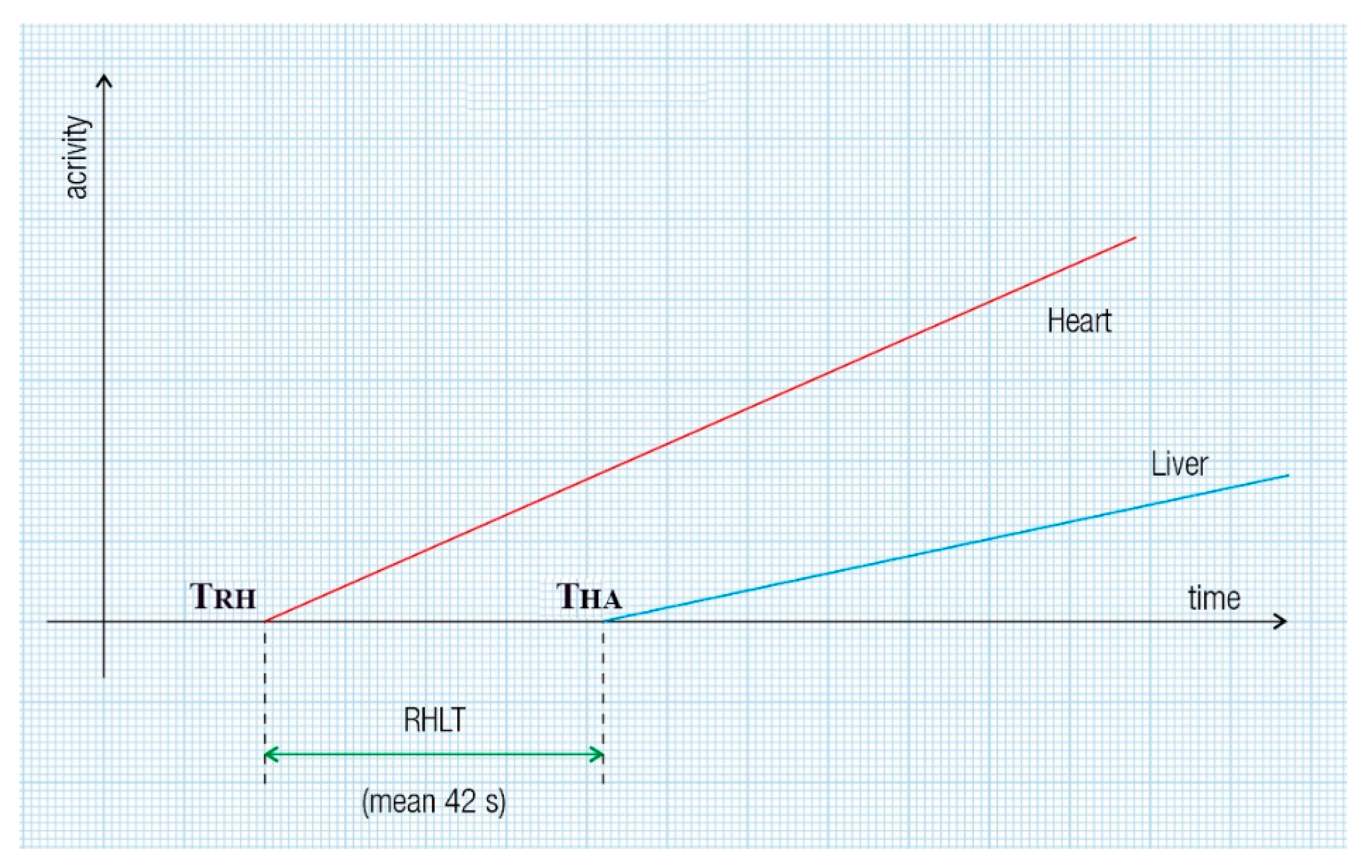

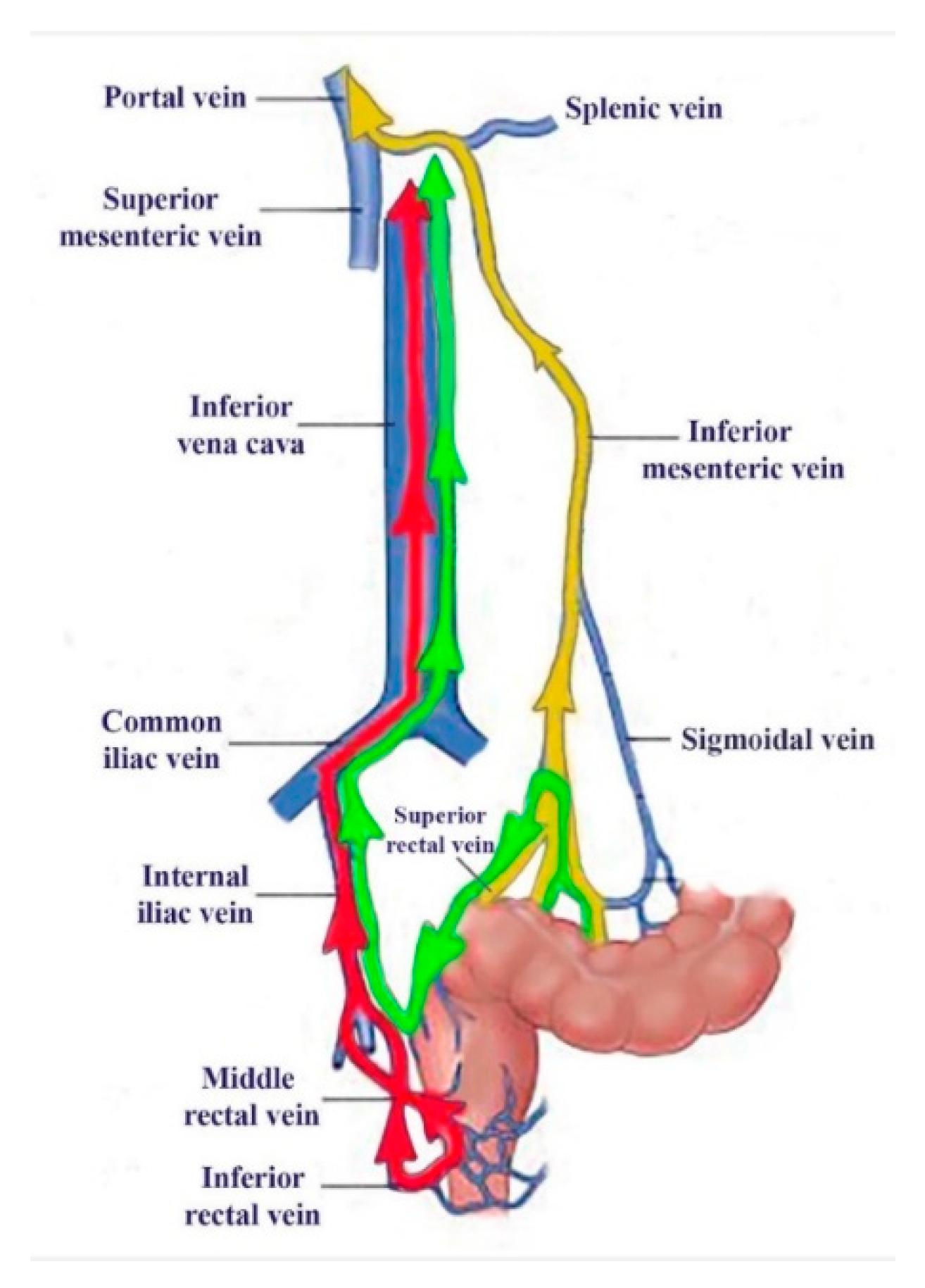
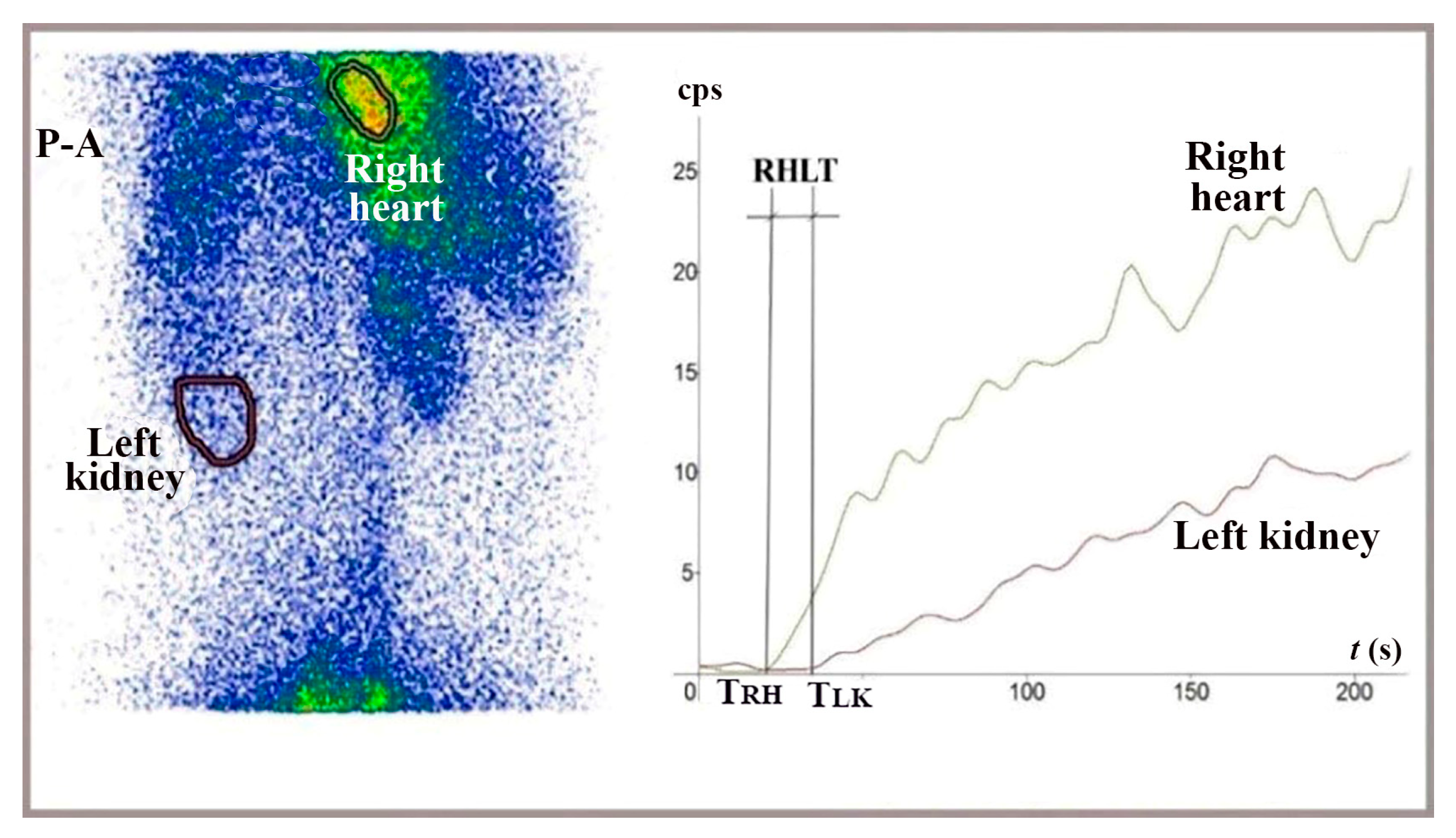
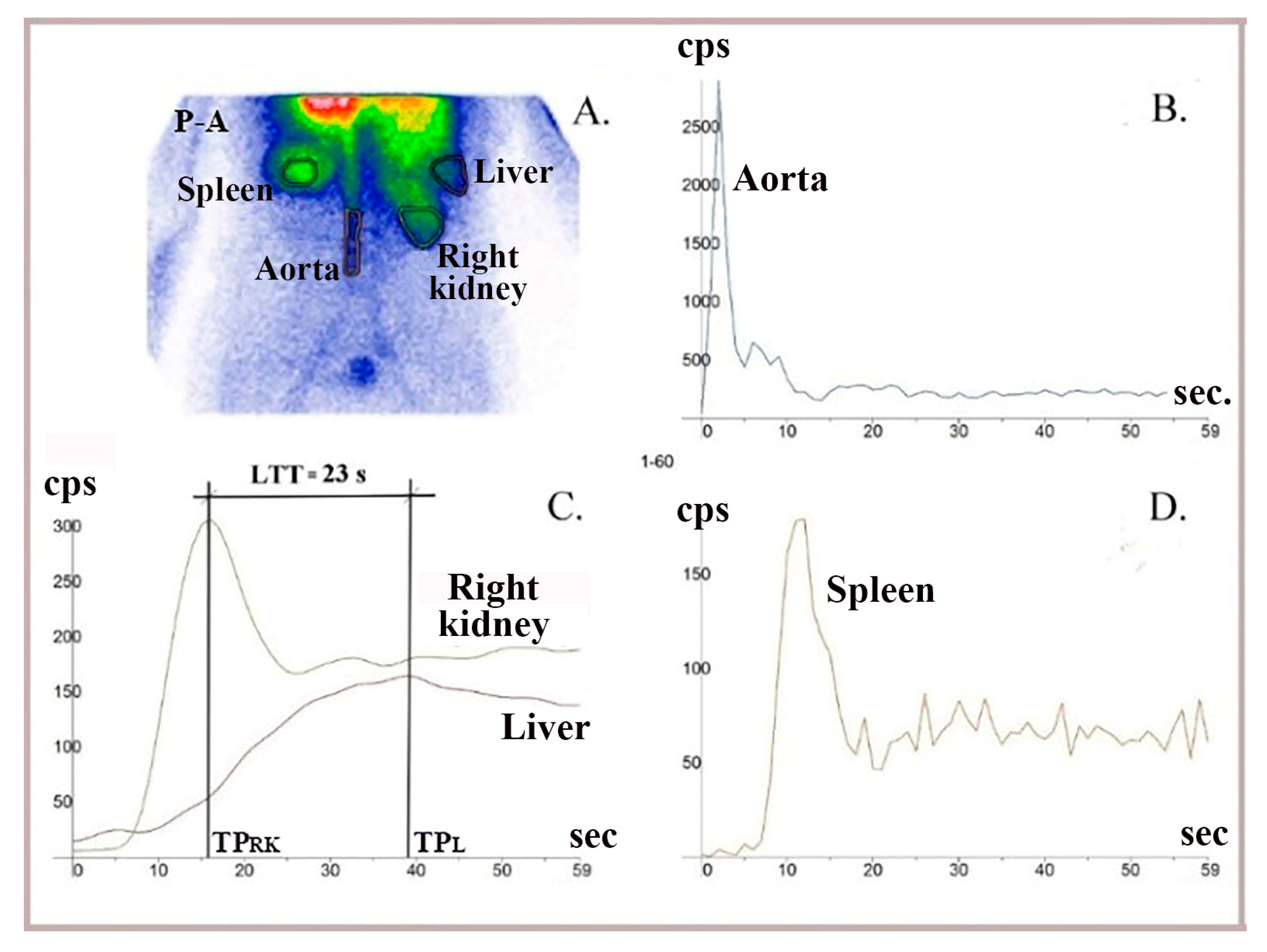
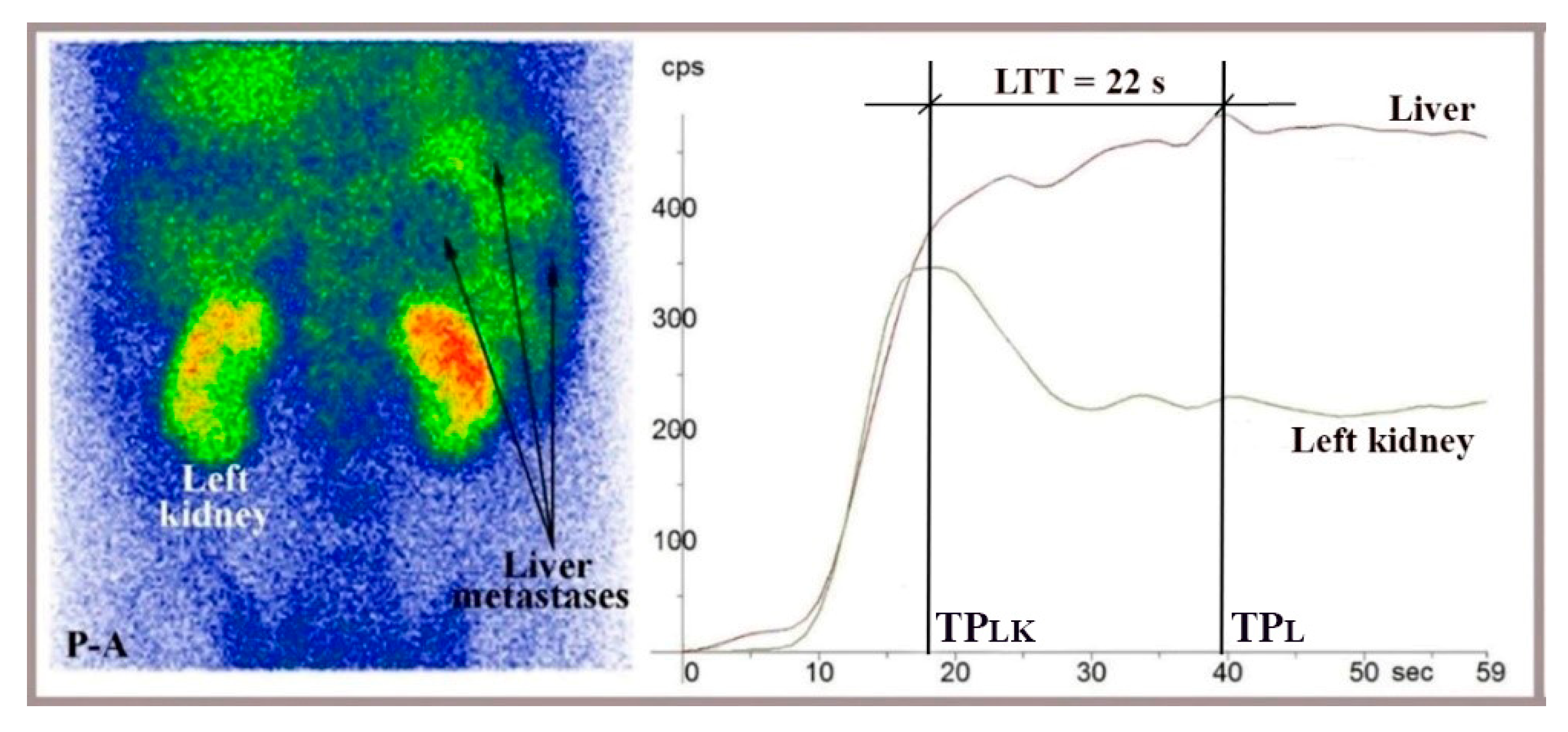
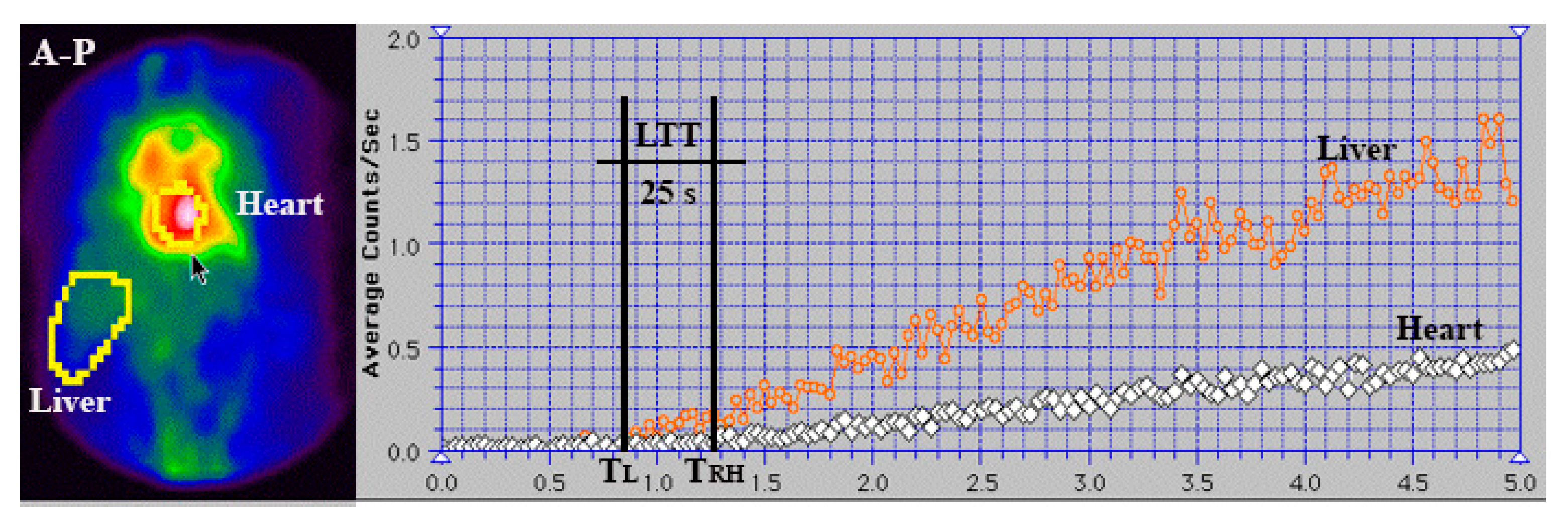
| Sr. No. | The Dynamic Scintigraphy Method Performed in This Study | Transit Time Value Determined | Significance of the Results |
|---|---|---|---|
| 1. | PRPS with RBC in vivo labelled with 99mTc-pertechnetate. | Highly increased LTT (23.5–25.5 s) and RHLT (39.5–42.5 s) | First-pass vasoconstriction is triggered in the liver and lungs in response to colorectal-absorbed 99mTc-pertechnetate, an artificial substance that is recognized during absorption as a potentially hazardous chemical (PHC). |
| 2. | LAS conducted to evaluate RHLT for 99mTc-pertechnetate intravenously injected as a bolus | Low value of RHLT (9–13 s) | 99mTc-pertechnetate and 99mTc-HDP, when injected intravenously, are not recognized in the lungs during the first pass as PHCs and, as a result, do not directly induce pulmonary vasoconstriction. |
| 3. | LAS conducted to evaluate RHLT for 99mTc-HDP intravenously injected as a bolus | Low value of RHLT (9.5–13.5 s) | |
| 4. | LR-TMDS conducted to evaluate RHLT for 99mTc-pertechnetate administered in the lower rectum submucosa | Low value of RHLT (12–15 s) | Even if 99mTc-pertechnetate crosses the other layers of the colorectal wall but is not absorbed through the mucosa, it does not directly activate first-pass vasoconstriction in the lungs. This indicates that the vasoactive agents responsible for vasoconstriction in PRPS are secreted in the colorectal mucosa. |
| 5. | LAS conducted to evaluate LTT for intravenously injected 99mTc-HDP, delivered to the gut mucosa through the arterial flow | Highly increased LTT (20–27 s) | Vasoconstriction also occurs in the liver when 99mTc-HDP is delivered via arterial flow to the gut mucosa and then through portal flow to the liver. |
| Sr. No. | Imaging Method | LTT | RHLT | Pulmonary Transit Time |
|---|---|---|---|---|
| 1. | PRPS with 99mTc-pertechnetate [1] | 23–25 s | 41–43 s | - |
| 2. | Trans-splenic portal scintigraphy (TSPS) with 99mTc-phytate [2] | 5–6 s | - | - |
| 3. | PET/CT with [82Rb]RbCl [3] | - | - | 5–13.4 s |
| 4. | Pulmonary radionuclide angiography with 99mTc-DTPA (diethylene-triamine-pentaacetate) [4] | 6.2–9.2 s | ||
| 5. | MRI [18] | 3.03 s | - | - |
| 6 | MRI [23] | - | - | 5.9–7.9 s |
| 7. | Contrast-enhanced ultrasound utilizing different echo-enhancers [19,20,21,22] | 6.33 s (BR1) 6.45 s (Sonazoid) 15.27 s (Sonovue) 9.597 s (Levovist) | - | - |
Disclaimer/Publisher’s Note: The statements, opinions and data contained in all publications are solely those of the individual author(s) and contributor(s) and not of MDPI and/or the editor(s). MDPI and/or the editor(s) disclaim responsibility for any injury to people or property resulting from any ideas, methods, instructions or products referred to in the content. |
© 2025 by the authors. Licensee MDPI, Basel, Switzerland. This article is an open access article distributed under the terms and conditions of the Creative Commons Attribution (CC BY) license (https://creativecommons.org/licenses/by/4.0/).
Share and Cite
Dragoteanu, M.; Tolea, Ș.; Duca, I.; Mititelu, R.; Kairemo, K. Hepatic and Pulmonary Vasoactive Response Triggered by Potentially Hazardous Chemicals After Passing Through the Gut Mucosa. Diagnostics 2025, 15, 2444. https://doi.org/10.3390/diagnostics15192444
Dragoteanu M, Tolea Ș, Duca I, Mititelu R, Kairemo K. Hepatic and Pulmonary Vasoactive Response Triggered by Potentially Hazardous Chemicals After Passing Through the Gut Mucosa. Diagnostics. 2025; 15(19):2444. https://doi.org/10.3390/diagnostics15192444
Chicago/Turabian StyleDragoteanu, Mircea, Ștefan Tolea, Ioana Duca, Raluca Mititelu, and Kalevi Kairemo. 2025. "Hepatic and Pulmonary Vasoactive Response Triggered by Potentially Hazardous Chemicals After Passing Through the Gut Mucosa" Diagnostics 15, no. 19: 2444. https://doi.org/10.3390/diagnostics15192444
APA StyleDragoteanu, M., Tolea, Ș., Duca, I., Mititelu, R., & Kairemo, K. (2025). Hepatic and Pulmonary Vasoactive Response Triggered by Potentially Hazardous Chemicals After Passing Through the Gut Mucosa. Diagnostics, 15(19), 2444. https://doi.org/10.3390/diagnostics15192444






